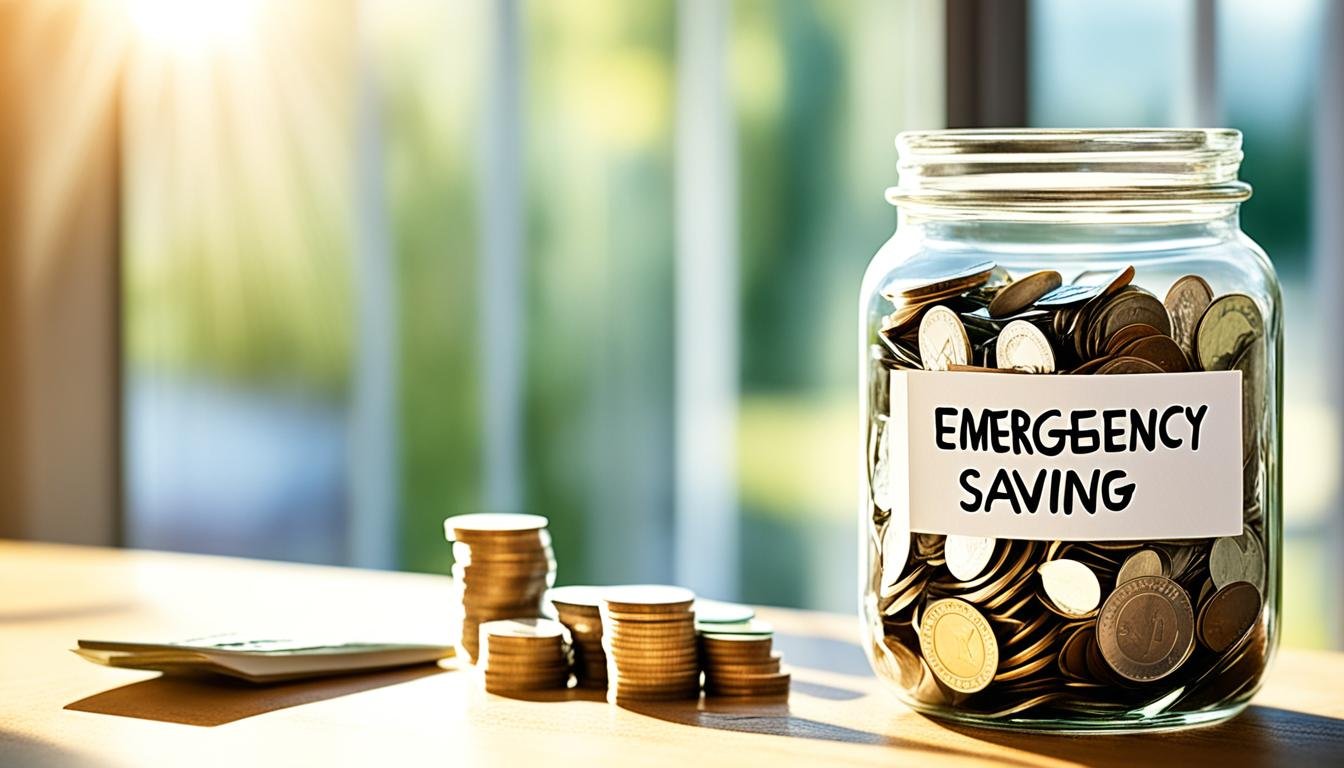

Starting an emergency savings fund is key to financial safety. It serves as a safety net for surprise costs. Things like a sudden job loss or unexpected medical bills become less stressful. With this fund, you can avoid debt during tough times. It’s a powerful step to managing your money well and facing challenges with confidence.
Table of Contents
ToggleKey Takeaways
- Emergency savings funds provide essential financial security.
- They help manage unforeseen expenses without incurring debt.
- Building such a fund allows you to take control of your finances.
- Every individual can benefit from having a rainy day fund.
- Preparation for emergencies reduces stress during difficult times.
- Learning how to start an emergency savings fund is achievable for everyone.
Understanding the Importance of an Emergency Fund
An emergency fund is key to financial safety. It lets people deal with surprises confidently. Life can throw curveballs, and being ready for them helps keep your finances steady.
What is an Emergency Fund?
An emergency fund is money saved for unexpected needs. It pays for things like sudden medical bills, car fixes, or if you lose your job. Experts suggest saving enough to cover living costs for three to six months.
Why You Need an Emergency Fund for Financial Security
Having an emergency fund means more financial security. It helps you through tough times without much worry. You won’t have to use credit cards or loans, which keeps you from getting into debt. This fund acts as a safety net and gives you peace of mind during emergencies.
| Benefit | Description |
|---|---|
| Financial Stability | Helps to ensure you can meet unexpected expenses without financial strain. |
| Stress Reduction | Provides peace of mind during emergencies, reducing anxiety related to financial struggles. |
| Debt Prevention | Avoids reliance on credit, minimizing the risk of debt accumulation due to emergencies. |
| Better Financial Planning | Encourages individuals to prioritize budgeting and savings, fostering long-term financial health. |
How to Start Your Emergency Savings Fund
Starting an emergency savings fund is vital for your financial safety. A systematic approach lets you save money well within your budget. Here is a simple guide to help you set up your emergency fund.
Step-by-Step Guide to Setting Up Your Fund
First, figure out a realistic savings goal. It should be based on your monthly costs. Aim for three to six months of living expenses. This will cover you for unexpected expenses. With a goal in mind, follow these steps:
- Create a separate savings account just for your emergency fund. Look for a high-yield savings account with good access and interest rates.
- Start automatic transfers to your savings account. This helps make saving a top priority every month.
- Regularly update your contributions. Do this if your financial situation or budget changes. This keeps your savings growing well.
Choosing the Right Savings Account
When picking a savings account for your emergency fund, focus on these points:
- Accessibility: You need an account that lets you take out money easily when needed.
- Interest Rates: Accounts with high interest rates help your savings grow faster.
- Fees: Choose an account with few or no fees to maximize your savings.
For more tips on starting an emergency savings fund, check out in-depth resources. Useful advice and strategies are available at this guide. Or look into articles about budgeting and setting savings goals.
| Criteria | Considerations |
|---|---|
| Accessibility | Easy withdrawals for emergencies |
| Interest Rates | Higher rates for better savings growth |
| Fees | Minimal or no fees should be preferable |
Implement these steps well to grow your emergency savings fund. By staying informed and disciplined with your budget and savings, you can ensure financial stability for the long term.
Assessing Your Financial Situation
Before starting to build an emergency fund, check your financial health. Understanding your income and listing your monthly expenses is key. This step helps in planning how much to save.
Review Your Current Financial Standing
First, collect all your financial information. Consider your income from jobs or investments. Knowing your total income clarifies your financial health. Then, compare it to your regular bills to see your financial position.
Identifying Monthly Expenses and Income
Next, list your monthly expenses. Split them into fixed and variable costs:
| Expense Type | Examples |
|---|---|
| Fixed Expenses | Rent, Utilities, Insurance |
| Variable Expenses | Groceries, Entertainment, Dining Out |
Understanding your spending is critical. Reviewing your expenses can show where to save money. Saving more can help build an emergency fund, which is comforting during surprise events.

Creating a Budget for Your Emergency Fund
Making a budget for your emergency fund is key to financial health. By saving a part of your monthly budget, you make a safety net for tough times. This step gets you ready for surprise costs and helps you control your money better.
How to Incorporate Savings into Your Monthly Budget
Good budgeting means adding savings on purpose. First, look at your income and what you spend. Then, decide how much money or what percentage of your income will go into your emergency fund. This could be a steady amount or change with how much you make. Budgeting apps help keep track of savings as you plan your finances.
Allocating Funds for Your Rainy Day Fund
To figure out your savings for an emergency fund, set goals for how much to save each month. The table below shows how to save based on different incomes:
| Monthly Income | Suggested Savings (10%) | Suggested Savings (15%) |
|---|---|---|
| $2,500 | $250 | $375 |
| $3,500 | $350 | $525 |
| $5,000 | $500 | $750 |
This way, you regularly add to your emergency fund while fitting your budget. Watch your spending each month. If you can, save a bigger part of your income. A stretchy budget helps your emergency fund grow, preparing you for anything unexpected.
Setting Savings Goals for Your Emergency Fund
Creating savings goals is key to a strong emergency fund. Knowing your goal helps with planning and staying motivated. First, look at your monthly costs. Then decide how many months you want to save for. This gives you a clear savings target.
Determining How Much You Need
Think about your essential monthly costs. This includes rent, utilities, food, and getting around. Multiply these by the months you want to be ready for surprises. This way, you find out your savings goal.
| Expense Type | Monthly Cost | Months Covered | Total Savings Goal |
|---|---|---|---|
| Rent | $1,200 | 6 | $7,200 |
| Utilities | $300 | 6 | $1,800 |
| Groceries | $400 | 6 | $2,400 |
| Transportation | $200 | 6 | $1,200 |
| Total | $12,600 |
Setting Achievable Short-term and Long-term Goals
After finding out how much you need, break it into smaller goals. Try saving a set amount every month. It keeps you going without getting too stressed.
Setting longer-term goals is also crucial. For example, aim to hit your total savings in a year. Doing so boosts your dedication and ensures financial stability.
Strategies for Saving Money Effectively
It’s crucial to have a plan for saving money to build a strong emergency fund. By setting up your savings to be automatic and finding ways to save in your budget, your financial health improves. This builds up your savings in no time.
Automating Your Savings Contributions
One top way to save is by making your savings automatic. Simply set an automatic transfer from your checking to your savings account. It stops you from spending that money and saves it without you having to remember. Most banks offer this, so you can start saving easily.
Finding Extra Savings in Your Budget
Take a look at your monthly expenses to see where you can spend less. You might find services you barely use that you can cancel. Saving any amount helps. Also, consider using cash-back apps and rewards programs to save more while shopping. These steps help you find extra money for your emergency fund. For more tips on saving money, check out this resource.

| Budget Item | Current Expense | Potential Savings |
|---|---|---|
| Cable Subscription | $100 | $50 |
| Gym Membership | $60 | $30 |
| Dining Out | $200 | $100 |
| Mobile Phone Plan | $80 | $20 |
By making these small changes, you can see big results in your budget savings strategies. You will reach your financial goals faster by managing your expenses and saving automatically. It makes a big impact on your saving abilities.
Overcoming Common Challenges in Saving
Saving money can be tough, especially when surprise bills pop up. Things like sudden medical costs or emergency house repairs can mess up your budget. It’s important to stay flexible in these times. By adjusting your budget, you can handle changes and keep saving.
Dealing with Unexpected Expenses
Having a plan for surprise costs is essential. Here are some ideas to help you through those tough times:
- Create a buffer in your budget for emergencies.
- Build up a foundation of savings that can cover 3 to 6 months of expenses.
- Prioritize important costs and cut back on extras to cover urgent needs.
Staying Motivated Throughout the Process
Keeping your motivation up is key to reaching your savings targets. Seeing your progress can help stay on track. Here are ways to keep motivated:
- Find an accountability partner to share goals and celebrate wins with.
- Use charts or graphs to see your savings grow. This makes success feel real.
- Regularly remind yourself of the peace of mind that an emergency fund brings.
Best Practices for Maintaining Your Emergency Fund
Knowing when to use your emergency fund is key. It’s important for keeping your fund ready for tough times. Adding money back into it after spending is also critical.
When to Use Your Emergency Fund
Knowing the right time to dip into your emergency fund can keep you financially secure. Here are times when it’s smart to use it:
- Job loss or reduction in income
- Unexpected medical expenses
- Major car repairs
- Emergency home repairs
These are real emergencies that justify using your savings. Using the fund for other reasons can weaken its purpose.
Replenishing Your Fund After Use
After using your emergency fund, getting it back to full is crucial. You can do this by:
- Adjusting your monthly budget to put more back into your fund
- Increasing what you put in until you hit your goal
- Keeping up with regular savings to keep the fund strong
Following these steps helps keep your emergency fund ready. This way, you’re prepared for any surprise hardships.
Emergency Preparedness Beyond Savings
Getting ready for emergencies isn’t just about saving money. It means planning carefully. It’s about understanding what might go wrong and acting ahead of time. This helps you be fully prepared for any emergency.
Planning for Financial Emergencies
First, figure out what financial emergencies could happen. These could be sudden bills for medical care, losing your job, or home repairs you didn’t expect. Once you know what might happen, you can plan for it. This lets you decide what’s most important and how to use your money best.
Insurance Options to Complement Your Emergency Fund
Insurance is crucial alongside your emergency funds. Look at different kinds of insurance for extra safety. Health, auto, and renter’s insurance cover large, unexpected costs. By choosing the right policies, you protect yourself better. This way, you strengthen your financial security no matter what happens.
Conclusion
Having an emergency savings fund is key to managing money well and feeling secure financially. By grasping its value and using the tips shared here, starting your emergency fund becomes manageable. A good financial safety net protects you from sudden costs and lets you tackle life’s surprises confidently.
To ensure your future is secure, it’s vital to use smart budgeting and set achievable saving targets. Making thoughtful decisions and adopting strong saving methods helps create a sturdy fund. This planned effort means you’re ready for life’s ups and downs.
The secret to keeping a financial safety net is to stay consistent and disciplined. Keep an eye on your finances and stick to your saving goals. Through commitment, you’ll gain the calmness that comes with being prepared for anything.
FAQ
What is an emergency savings fund?
An emergency savings fund is money saved to help with sudden costs. This might be for things like medical bills, car troubles, or losing a job. It keeps you from having to borrow money during tough times.
How much should I have in my emergency fund?
You should aim to save enough to cover three to six months of living costs. This helps you stay prepared for unforeseen events. It’s a key part of being financially secure.
How do I start building my emergency savings fund?
Start by picking a savings goal linked to what you spend each month. Find a good savings account. Then set up auto-transfers from checking to savings. Over time, adjust how much you save to grow your fund.
What expenses should be considered when budgeting for an emergency fund?
Think about your must-pay expenses each month. This includes rent, utilities, food, getting around, and insurance. Knowing these costs helps you figure out how much to save.
How can I incorporate savings for my emergency fund into my current budget?
Look over what you earn and spend each month. Find places to spend less on things you don’t need. Then, save a part of your income for emergencies. Using budget tools can also help track your saving progress.
What should I do if unexpected expenses occur while saving for my emergency fund?
Be ready to adjust. If you have surprise costs, see where you can cut back on saving for a bit. Cover must-have expenses first. Once things are back to normal, go back to saving for emergencies.
How can I stay motivated to build my emergency fund?
Make small savings goals that are easy to hit and celebrate when you do. Tracking your savings visually with charts or apps can also make your goal feel real. This helps you keep saving regularly.
What are some best practices for maintaining my emergency fund?
Only use the emergency money when you really need to. Always fill it back up after you use it. Check your budget often to keep your emergency savings strong. This helps your financial safety last.
What insurance options should I consider alongside my emergency fund?
Think about getting health, car, and home or rental insurance. These can take care of big costs you didn’t expect. They make your financial plan even stronger.

As a trusted news source, Editorial Fox prides itself on upholding the highest standards of journalistic integrity. Our commitment to accuracy and fairness ensures that our readers can rely on us for reliable information.
Mail: info@editorialfox.com
About Editorial Fox
At Editorial Fox, we are committed to delivering high-quality journalism that informs and engages our readers. Our team of experienced journalists and editors work tirelessly to bring you the latest news and analysis from around the world.
Copyright @2024 Editorialfox.com All Right Reserve.


Be the first to leave a comment